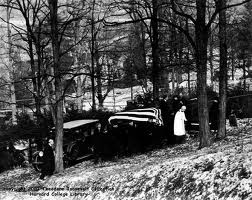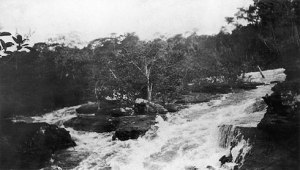Proving once again, I am not above using a shameless pop culture reference with “Back to the Future” to drive traffic! What I really want to talk about is not the great movie trilogy (well, at least the first one was great) but rather, leveraging the past to change the future.
About 100 years ago, George Santayana penned his oft repeated line, “Those who cannot remember the past are condemned to repeat it.” This phrase has been quoted (and misquoted) over the last century. Using three vignettes from history, let’s explore the past for some lessons we can use as leaders to shape our future.
Benjamin Harrison & Theodore Roosevelt: The Center and Edge

In 1888 Benjamin Harrison was running for President of the United States. A young up-and-comer, Theodore Roosevelt, was canvassing the midwest, feverishly campaigning for Harrison. After Harrison won the election and became our 23rd President, he appointed Roosevelt to serve on the Civil Service Commission.
A rather ironic appointment, wouldn’t you say? Why ironic, you ask? Well, the mission of the Civil Service Commission was to stamp our cronyism and ensure government employees were hired based on their merits rather than by quid pro quo appointments.
Wanting to prove to the country he was his own man, Roosevelt started his work to clean up the federal government in, of all places, Indianapolis, Indiana, Benjamin Harrison’s own backyard!
Roosevelt continued living on the edge throughout his entire career. Always challenging the status quo, always pushing the envelope. While this did not win many fans with the party bosses, who oft times were targets, it did make him one of the most popular presidents in history.
When you think of living life on the edge, what images come to mind? Bleeding edge? Cutting edge? Edge of the earth? Each of these conjure up the dangers associated with the “edge”.
 I’d like to give you a new image to consider for living on the edge. Many of you who know me, know I am a river rat. I would rather be canoeing a river than doing just about anything else on the planet. A technique for making your way downstream in turbulent waters is to use the eddies, those calm areas of water that form behind an obstruction. A canoeist or kayaker can enter the eddy, rest, regather, regroup, and scout the river ahead.
I’d like to give you a new image to consider for living on the edge. Many of you who know me, know I am a river rat. I would rather be canoeing a river than doing just about anything else on the planet. A technique for making your way downstream in turbulent waters is to use the eddies, those calm areas of water that form behind an obstruction. A canoeist or kayaker can enter the eddy, rest, regather, regroup, and scout the river ahead.
Using the eddies is not without its dangers, however. Entering and exiting the eddy can be challenging. The line (eddy line) or edge that forms between the fast flowing water of the main channel and the calm, still waters of the eddy can be difficult to navigate. One has to attack the edge at just the right angle to enter the eddy. When ready to proceed, one again has to attack the edge with confidence to re-enter the river.
Roosevelt knew when he need to recharge and regroup, but he also knew to make progress and to make change, as a leader, you have to attack the edge!
George Marshall & Dwight D. Eisenhower: Train for the Future

It was early in the 1940’s and history was about to repeat itself. Europe was already engulfed in war and it was only a matter of time before the U.S. would get involved. Over the last several months, the U.S. built its fighting force. From a peacetime corp, the military ranks swelled to 1.4 million soldiers.
The few remaining veterans were comfortable re-fighting World War I. However, Nazi Germany had done in four months with it’s predecessor had not done in four years…seize all of Europe. Marshall knew these new soldiers would need to be trained before the U.S. entered the fray. To accomplish this training he ordered war games to take place in Louisiana, known to history has the Louisiana Maneuvers.
With that order, more than 500,000 soldiers descended upon Louisiana and some other southern states. But Marshall was doing more than just training the troops. He was looking for leaders. He was looking for leaders that could demonstrate a new approach, not just use the same tired techniques because they “worked in the past”. In short, he was looking for Colonels who could be Generals.
 31 of the 42 Division Commanders were replaced during or after the Louisiana Maneuvers. Among those new leaders? Dwight D. Eisenhower.
31 of the 42 Division Commanders were replaced during or after the Louisiana Maneuvers. Among those new leaders? Dwight D. Eisenhower.
Business has changed dramatically in the last 20 years. What worked in the past will not work today. Business is changing at an ever increasing pace. What works today will not work in the future. We need new skills, we need new processes. Will the next generation of leaders be ready? Can we help them see the future? Can we help them see the new skills? Can we help them be ready to lead their teams?
Like Marshall, we have to train for the future!
Lewis and Clark & Thomas Jefferson
 (You knew they’d be in here somewhere, didn’t you?)
(You knew they’d be in here somewhere, didn’t you?)
It was 1806. The Lewis and Clark Expedition had departed from St. Louis almost three years prior. They had traveled about five or six thousand miles by boat, by foot, by canoe. They had narrowly escaped death at the hands of the Teton Sioux, nearly froze to death in the harsh winters, survived temperatures in excess of 100 degrees, and had to eat their horses to survive starvation in the Rocky Mountains. Now, finally on their way back home to “those United States” they were stuck. The snow on the mountains was too deep to cross. They returned to the Nez Perce villages and waited….almost two months.
During this time they developed a new plan for their return trip. Over the course of the journey the Captains had learned some facts that Jefferson could not have known. Armed with this new information they had a choice. They could wait…return to civilization…provide the information to Jefferson…ask him what to do, then carry out his instructions. Or, they could take a risk! Based on their knowledge of Jefferson, their knowledge of the new facts, and an understanding of the goals of the mission…they decided to split into four groups.
 Pretty significant risk, wouldn’t you say? Dividing what was already a small Corps into four smaller teams and heading out into the still very much unknown? Call it taking risks, call it taking initiative. To be a leader, we have to know when to take these types of educated risks. History does not tell us about Jefferson’s reaction to this risk, nor do we know the “what ifs”. The decision could have lead to untold catastrophes. How would Jefferson have reacted if their journals had been destroyed, or if they had lost some of the precious discoveries, or if some of them had been killed? As leaders, not only do we have to be willing to take risks, but we have to provide an environment and a culture for our employees, leaders and future leaders, to be able to take risks, to be able to fail, and to be able to succeed.
Pretty significant risk, wouldn’t you say? Dividing what was already a small Corps into four smaller teams and heading out into the still very much unknown? Call it taking risks, call it taking initiative. To be a leader, we have to know when to take these types of educated risks. History does not tell us about Jefferson’s reaction to this risk, nor do we know the “what ifs”. The decision could have lead to untold catastrophes. How would Jefferson have reacted if their journals had been destroyed, or if they had lost some of the precious discoveries, or if some of them had been killed? As leaders, not only do we have to be willing to take risks, but we have to provide an environment and a culture for our employees, leaders and future leaders, to be able to take risks, to be able to fail, and to be able to succeed.
Progress and Change
The worlds of business and technology are changing at an ever accelerating pace. We as leaders need to understand where we have been, as well as, see where we are going. We must become comfortable living on the edge, or risk being sucked into the whirlpool of the status quo. We must train our teams and our leaders for the future. What worked in the past will not work in the days ahead. We must also know when to take educated risks and provide an environment that empowers our teams to take risks, lest we leave significant “discoveries” on the table.
History can and does repeat itself, regardless of the lessons learned. Armed with your knowledge of the past, how will you make progress by changing the future? Let’s revisit Mr. Santayana and his quote…in context:
“Progress, far from consisting in change, depends on retentiveness. When change is absolute there remains no being to improve and no direction is set for possible improvement: and when experience is not retained, as among savages, infancy is perpetual. Those who cannot remember the past are condemned to repeat it.”
This post is derived from a talk by the same name given for Sparks Tech. View the video here.
Connect with Jeff on LinkedIn.
or Follow Him on Twitter (@jtonindy)
Jeff blogs on a variety of platforms:
Business related topics: LinkedIn
IT and the role of the CIO: Intel’s IT Peer Network
Life, Family, Love, Leadership and History: Rivers of Thought
Leadership and Leadership Development: People Development Magazine

 Over the last several months, I have been struggling with the decision to leave a job that I love and to embark on a journey down a new stretch of river. Yes, I am leaving the role of CIO for Goodwill Industries of Central Indiana to join
Over the last several months, I have been struggling with the decision to leave a job that I love and to embark on a journey down a new stretch of river. Yes, I am leaving the role of CIO for Goodwill Industries of Central Indiana to join 




 “OK, everyone we are going to play a game! Everyone has to listen, and there are going to be rules!,” he shouted as he approached the microphone…wearing pink rabbit ears. He then told the story of the infamous “Cuffel Easter Egg Hunt”. He started by asking who had even heard of the Egg Hunt. Of the 90+ people there, most everyone raised their hand. “Who has participated in the Easter Egg Hunt?” Very few hands were lowered.
“OK, everyone we are going to play a game! Everyone has to listen, and there are going to be rules!,” he shouted as he approached the microphone…wearing pink rabbit ears. He then told the story of the infamous “Cuffel Easter Egg Hunt”. He started by asking who had even heard of the Egg Hunt. Of the 90+ people there, most everyone raised their hand. “Who has participated in the Easter Egg Hunt?” Very few hands were lowered.

 It was a cold, gray January day. The wind picked up the dusting of snow from the ground and flung it into their faces, stinging like needles. Tears froze to wind burned cheeks. The casket was slowly lowered into the frozen ground. A lone bugler played taps. Slowly, one by one, the people who had gathered, made their way down the 26 steps, down the long hill, and out of the cemetery until a lone figure remained. He stood motionless. His gaze locked on the hole before him. Tears stained his ruddy cheeks. His long coat flapped in the wind. His lips moved as if talking. Was he saying goodbye? Was he saying a prayer? Was he saying words of forgiveness to his now dead friend?
It was a cold, gray January day. The wind picked up the dusting of snow from the ground and flung it into their faces, stinging like needles. Tears froze to wind burned cheeks. The casket was slowly lowered into the frozen ground. A lone bugler played taps. Slowly, one by one, the people who had gathered, made their way down the 26 steps, down the long hill, and out of the cemetery until a lone figure remained. He stood motionless. His gaze locked on the hole before him. Tears stained his ruddy cheeks. His long coat flapped in the wind. His lips moved as if talking. Was he saying goodbye? Was he saying a prayer? Was he saying words of forgiveness to his now dead friend?




